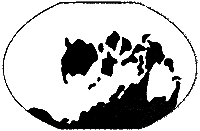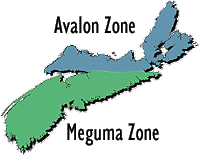    |
| Silurian Period Explosion of Life (438-408 mya) |
 Global View - Where was Nova Scotia? Global View - Where was Nova Scotia?There were two main landmasses during the Silurian Period. The southern continent of Gondwanaland consisted of South America, Africa, Madagascar, India, Australia and Antarctica. The northern continent Laurasia consisted of North America, Greenland, Europe and most of Asia.
Rocks of Nova Scotia Silurian rocks in Nova Scotia are remarkable for their differences. The oldest Palaeozoic rocks in the Cobequid Highlands are early marine Silurian siltstones with graptolite fossils. The Middle Silurian red sedimentary beds of the Moydart Formation were most likely deposited by streams. In the Cape Breton Highlands, the thick succession of sedimentary and volcanic rocks of the Jumping Brook Complex and similar units were deposited in marine environments and later strongly deformed and metamorphosed. On Ingonish Island a small section of felsic and mafic volcanic rocks were deposited during the Silurian Period. The Arisaig Group is composed mainly of shales and fine-grained sandstones that were deposited in warm, shallow seas. These rocks contain a great variety of fossils. By comparison, the White Rock Formation and other units found in southern Nova Scotia have few fossils, an observation that geologists believe may indicate a hostile or nutrient deficient environment. The similarity of the fossil faunas of the Arisaig Group to those of northern Europe suggests that Nova Scotia's Avalon Zone was affiliated with that continental plate in the Silurian Period. Paleoenvironment
Many of the animals either lived anchored to the sea floor or buried in the mud and silt below. Some, such as trilobites and gastropods, crawled on the sea floor to scavenge food, while others, such as nautiloids, swam as predators. Most of the animals that lived on or in the sea floor filtered the water to feed on microscopic plants and animals. Brachiopods were very common. Silurian fossils can be seen at Arisaig, on Nova Scotia's Northumberland shore. |
 The Avalon and Meguma Zones of Nova Scotia were widely separated because
they belonged to different continental landmasses. The Avalon Zone was part of the
northern European continental plate (in Laurasia), while the Meguma Zone was located off
the shore of what is now considered Africa (part of Gondwanaland).
The Avalon and Meguma Zones of Nova Scotia were widely separated because
they belonged to different continental landmasses. The Avalon Zone was part of the
northern European continental plate (in Laurasia), while the Meguma Zone was located off
the shore of what is now considered Africa (part of Gondwanaland).  The seas of the Silurian Period were warm,
shallow and teeming with life. The climate was very warm and humid, but layers of broken
shells (called coquina) are strong evidence of a climate dominated by storms.
The seas of the Silurian Period were warm,
shallow and teeming with life. The climate was very warm and humid, but layers of broken
shells (called coquina) are strong evidence of a climate dominated by storms.